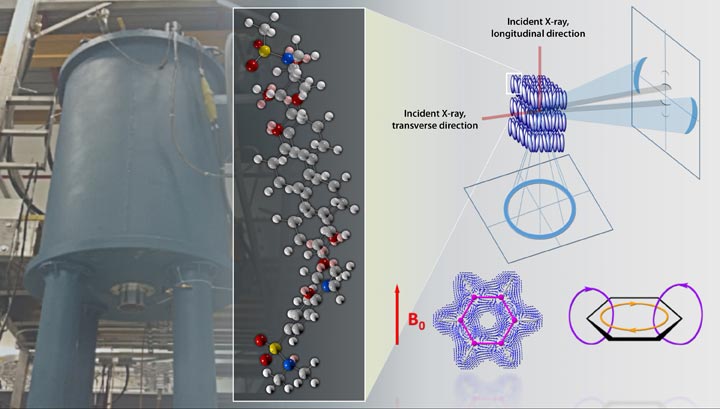ORNL thermomagnetic processing method provides path to new materials

The high magnetic field environments are provided by fully recondensing commercial prototype superconducting magnet processing system. The electromagnetic fields turn and align the liquid crystal phase forming a pseudo super-structure of ordered domains. This leads to advanced physical properties such as near-zero coefficient of thermal expansion.
Polymers are used in cars, planes and hundreds of consumer products, and scientists have long been challenged to create polymers that are immune to shape-altering thermal expansion. One way to achieve this goal is to develop highly directional crystalline structures that mimic those of transparent liquid crystal diode, or LCD, films of television and computer screens.
Unfortunately, polymers typically feature random microstructures rather than the perfectly aligned microstructure – and transparency – of the LCD film.
ORNL’s Orlando Rios and collaborators at Washington State University have pushed this barrier aside with a processing system that changes the microstructure and mechanical properties of a liquid crystalline epoxy resin.
Their finding, outlined in a paper published in the American Chemical Society journal Applied Materials and Interfaces, offers a potential path to new structural designs and functional composites with improved properties.
The method combines conventional heat processing with the application of powerful magnetic fields generated by superconducting magnets. This provides a lever researchers can use to control the orientation of the molecules and, ultimately, the crystal alignment.
“In this way, we can achieve our goal of a zero thermal expansion coefficient and a polymer that is highly crystalline,” said Rios, a member of ORNL’s Deposition Science Group. “And this means we have the potential to dial in the desired properties for the epoxy resin polymers that are so prevalent today.”
Epoxy is commonly used in structural composites, bonded magnets and coatings. Rios noted that thermosets such as epoxy undergo a chemical cross-linking reaction that hardens or sets the material. Conventional epoxy typically consists of randomly oriented molecules with the molecular chains pointing in every direction, almost like a spider web of atoms.
“Using thermomagnetic processing and magnetically responsive molecular chains, we are able to form highly aligned structures analogous to many stacks of plates sitting on a shelf,” Rios said. “We confirmed the directionality of this structure using X-ray measurements, mechanical properties and thermal expansion.”
Co-authors of the paper, “Thermomagnetic processing of liquid crystalline epoxy resins and their mechanical characterization using nanoindentation,” are Yuzhan Li and Michael Kessler of Washington State’s School of Mechanical and Materials Engineering.
The ORNL portion of the research was supported by the Critical Materials Institute, an Energy Innovation Hub funded by DOE’s Office of Energy Efficiency and Renewable Energy. Washington State’s research was funded by the Air Force Office of Scientific Research.
UT-Battelle manages ORNL for the Department of Energy's Office of Science. The Office of Science is the single largest supporter of basic research in the physical sciences in the United States, and is working to address some of the most pressing challenges of our time. For more information, please visit http://science.energy.gov/
Media Contact
All latest news from the category: Materials Sciences
Materials management deals with the research, development, manufacturing and processing of raw and industrial materials. Key aspects here are biological and medical issues, which play an increasingly important role in this field.
innovations-report offers in-depth articles related to the development and application of materials and the structure and properties of new materials.
Newest articles

NASA: Mystery of life’s handedness deepens
The mystery of why life uses molecules with specific orientations has deepened with a NASA-funded discovery that RNA — a key molecule thought to have potentially held the instructions for…

What are the effects of historic lithium mining on water quality?
Study reveals low levels of common contaminants but high levels of other elements in waters associated with an abandoned lithium mine. Lithium ore and mining waste from a historic lithium…

Quantum-inspired design boosts efficiency of heat-to-electricity conversion
Rice engineers take unconventional route to improving thermophotovoltaic systems. Researchers at Rice University have found a new way to improve a key element of thermophotovoltaic (TPV) systems, which convert heat…



